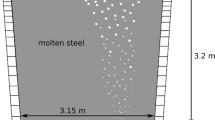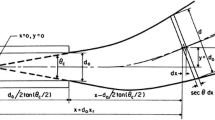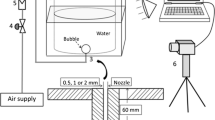Abstract
The behavior of gas discharging into a liquid has been investigated in the labora-tory and in plant. The laboratory work has involved the injection of different gases from a submerged, horizontal tuyere into water, zinc-chloride solution, and a mercury bath. High speed cinematography and pressure measurements in the tuyere have been carried out to characterize the flow regimes. In the case of the mercury bath, a novel “half-tuyere” has been developed to permit visual observation of the gas. In this way, two regimes of flow, bubbling and steady jetting, have been delineated as a function of the modified Froude number and the ratio of gas to liquid densities. Pressure measurements at the tuyere tip have been correlated to the different stages of bubble growth in the bubbling regime, and can be used to distinguish one flow regime from the other. The measured bubble frequency and volume correspond reasonably well to predictions of a simple model of bubble growth under conditions of constant flow. The forward penetration of the jet centerline from the tuyere tip has been measured and found to depend both onN Fr′ andρg/ρl. In the industrial tests, pressure taps have been installed in the tuyeres of a nickel converter to monitor the pressure wave of the jets under normal, low pressure blowing operations. The measurements show that the converter jets operate in the bubbling mode with a bubble frequency of 10 to 12 s−1, similar to a gas jet in mercury. Tests involving higher pressure injection indicate that the steady jetting, or underexpanded, regime obtains at pressures of about 340 kPa (50 psi). Based on equivalent experiments in the laboratory, it is clear that low pressure blowing has the disadvantage of poor penetration of air into the bath so that the jets rise close to the back wall and locally accelerate refractory wear. Moreover between the formation of successive bubbles, the bath washes against the tuyere mouth and contributes to accretion formation. This necessitates periodic punching of the tuyeres which also contributes to refractory wear at the tuyere line. The use of high pressure injection to achieve steady jetting conditions, as currently practiced in the new bottom blown steelmaking processes, should be considered to solve these prob-lems, and possibly usher in a new generation of nonferrous converters.
Similar content being viewed by others
References
G.N. Oryall and J.K. Brimacombe:Met. Trans. B, 1976, vol. 7B, pp. 391–403.
A. V. Spesivtsev, V. V. Mechev, G. B. Strekalovskii, and A. V. Vanyukov:Tsvet. Metall., 1973, vol. 14, no. 2, pp. 10–12.
R. Kumar and N. R. Kuloor:Adv. Chem. Eng., 1979, vol. 8, pp. 255–368.
R. Clift, J. R. Grace, and M. E. Weber:Bubbles, Drops, and Particles, pp. 321–28, Academic Press, NY, 1978.
J. F. Davidson and B. O. G. Schuler:Trans. Inst. Chem. Eng., 1960, vol. 38, pp. 335–42.
J. K. Walters and J. F. Davidson:J. FluidMech., 1962, vol. 12, pp. 408–16.
J. F. Davidson and D. Harrison:FluidizedParticles, 1963, Cambridge Univ. Press, London and New York.
G.A. Irons and R. I. L. Guthrie:Met. Trans. B, 1978, vol. 9B, pp. 101–10.
R. J. Andreini, J. S. Foster, and R. W. Callen:Met. Trans. B, 1977, vol. 8B, pp. 625–31.
J. W. McKelliget, M. Cross, R. D. Gibson, and J. K. Brimacombe: Unpublished work, Sunderland Polytechnic, Sunderland, U.K., 1979.
G. Savard and R. Lee: U.S. Patent No. 2,855,293, October 7, 1958.
Author information
Authors and Affiliations
Additional information
An erratum to this article is available at http://dx.doi.org/10.1007/BF02670149.
Rights and permissions
About this article
Cite this article
Hoefele, E.O., Brimacombe, J.K. Flow regimes in submerged gas injection. Metall Trans B 10, 631–648 (1979). https://doi.org/10.1007/BF02662566
Received:
Issue Date:
DOI: https://doi.org/10.1007/BF02662566




